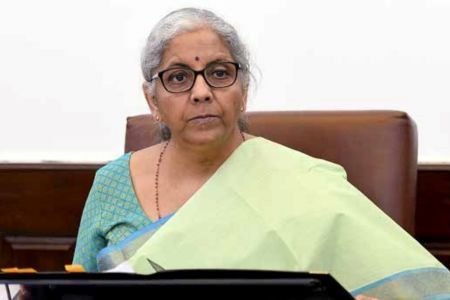Infrastructure development plays an important role in fulfilling the vision of India.

The importance of well-developed infrastructure for enhancing economic activity, and creating additional fiscal space by improving the government’s revenue base, cannot be ever undermined. Infrastructure development plays an important role in fulfilling the vision of India becoming a vishwaguru.
No doubt, given the strong backward and forward linkages and the positive externalities that infrastructure generates, it can be a vehicle for social and economic transformation Infrastructure creation in India has suffered for decades from multiple issues. There was a lack of coordination between different Departments.
Steps have also been taken to address the other problems like the time-taking approval process, the multiplicity of regulatory clearances etc. The government has ensured unprecedented focus on infrastructure through a holistic outlook in the last seven years.
“The pandemic and its associated economic disruption are prompting new ideas on infrastructure. Governments around the world are investing in infrastructure to deal with this new reality and help jumpstart recovery,” according to the latest report by Delloite. NITI Aayog has been implementing a structured initiative, ‘Development Support Services for States (DSSS) for Infrastructure Projects’, with the vision to achieve transformational and sustained delivery of infrastructure projects. The key objective behind the initiative is to create PPP success stories and reboot infrastructure project delivery models to establish a sustainable infrastructure creation cycle.
The NITI Aayog is involved in initiating policies that would ensure the country’s time-bound creation of world-class infrastructure. This section focuses on power, bridges, dams, roads and urban infrastructure development.
Details of the projects, organisations, policies, timelines, schemes, and spending on infrastructure are provided for the users.
According to the Union Budget 2021-22 documents, Public-Private Partnership in infrastructure has been an important source of investment in the sector. As per the database of the World Bank on private participation in infrastructure, India is ranked second among developing countries both by the number of PPP projects as well as the associated investments. Much of the Indian success in PPPs is attributed to developing robust institutional structures, financial support, and standardized documents. In both process documents, like Model Request for Qualification and Model Request for Proposal, as well as substantive documents like the Model Concession Agreements across infrastructure sectors.
The commitment of the NDA government led by Prime Minister Narendra Modi to developing infrastructure is reflected in the quick decisions. The Public Private Partnership Appraisal Committee (PPPAC), responsible for the appraisal of PPP projects, has cleared 66 projects with a total project cost of Rs. 137218 crores from 2014-15 to 2020-21. The government launched the Viability Gap Funding (VGF) scheme for providing financial assistance to financially unviable but socially/ economically desirable PPP projects. This scheme funded up to 20 percent of the project cost as a grant. Based on the above, the total VGF amount disbursed between 2014- 15 to 2020-21 by the Department of Economic Affairs is Rs.2943 crores.
The government felt that a focused long term planning is critical for strengthening and growing the infrastructure in the country. A National Infrastructure Pipeline (NIP) was launched with a projected infrastructure investment of around Rs. 111 lakh crore during FY 2020-2025 to provide world-class infrastructure across the country and improve the quality of life for all citizens.
NIP was launched with 6,835 projects, which has expanded to over 9,000 projects covering 34 sub-sectors. NIP is a first-of-its-kind, whole-of-government exercise and covers all infrastructure sub-sectors, including MSMEs working in the infrastructure sector, as mentioned in Harmonized Master List of Infrastructure Subsectors notified by DEA.
Since 2015, the government has planned and launched various infrastructure projects and has also ensured that they are properly monitored and executed. Traditionally, there was a lack of coordination between different Departments; for example, once a road was constructed, other agencies dug up the constructed road again for activities like laying underground cables, gas pipelines etc. This not only caused great inconvenience but was also a wasteful expenditure. To address this, efforts were made to increase coordination so that all cables, pipelines etc. could be laid simultaneously.
Steps have also been taken to address other issues like the timetaking approval process, multiplicity of regulatory clearances etc. The government has ensured unprecedented focus on infrastructure through a holistic outlook in the last few years.
This helps address past issues by institutionalizing holistic planning for stakeholders for major infrastructure projects. Instead of planning & designing separately in silos, the projects will be designed and executed with a com-mon vision.
A senior official in the government said the government’s monitoring mechanism toavoid these projects’ cost/time overrun. Importantly there are Periodic reviews of projects under PRAGATI through video conferencing by the Prime Minister; rigorous project appraisal; Online Computerized Monitoring System (OCMS) for better monitoring; setting up of Revised Cost Committees in the Ministries for fixation of responsibility for time and cost overruns; regular review of infrastructure projects by the concerned administrative Ministries and setting up of Central SectorProjects Coordination Committees (CSPCCs) in the States under the Chief Secretaries for removal of bottlenecks and for facilitating the speedy implementation of major projects.
Fast Forwarding Infrastructure in India
Taking forward the efforts of the past seven years, the Union Finance Minister Nirmala Sitharaman announced a mega plan that is bound to propel India to have an enhanced robust infrastructure. In her Union Budget 2022-23, she announced PM GatiShakti, a transformative approach to economic growth and sustainable development.
In her speech, she said the approach is driven by seven engines: Roads, Railways, Airports, Ports, Mass Transport, Waterways, and Logistics Infrastructure. All seven engines will pull forward the economy in unison. These engines are supported by the complementary roles of Energy Transmission, IT
Communication, Bulk Water & Sewerage, and Social Infrastructure. Finally, she added thatClean Energy and SabkaPrayas power the approach – the efforts of the Central Government, the state governments, and the private sector together – leading to huge job and entrepreneurial opportunities for all, especially the youth.
PM GatiShakti National Master Plan
The scope of PM GatiShakti National Master Plan will encompass the seven engines for economic transformation, seamless multimodal connectivity and logistics efficiency. It will also include the infrastructure developed by the state governments as per the GatiShakti Master Plan. The focus will be on planning, and financing, including through innovative ways, use of technology, and speedier implementation.
The projects about these seven engines in the National Infrastructure Pipeline will be aligned with the PM GatiShakti framework. The touchstone of the Master Plan will be worldclass modern infrastructure and logistics synergy among different modes of movement – both of people and goods – and the location of projects. This will help raise productivity and accelerate economic growth and development. PM GatiShakti National Master Plan is essentially a digital platform to bring 16 Ministries, including Railways and Roadways, together for integrated planning and coordinated implementation of infrastructure connectivity projects.The multimodal connectivity will provide integrated and seamless connectivity for the movement of people, goods and services from one mode of transport to another. It will facilitate the last mile connectivity of infrastructure and reduce travel time for people.
PM GatiShaktiwill incorporate the infrastructure schemes of various Ministries and State Governments like Bharatmala, Sagarmala, inland waterways, dry/land ports, UDAN etc. Economic Zones like textile clusters, pharmaceutical clusters, defence corridors, electronic parks, industrial corridors, fishing clusters, and agri zones will be covered to improve connectivity & make Indian businesses more competitive. It will also leverage technology extensively, including spatial planning tools with ISRO (Indian Space Research Organisation) imagery developed by BiSAG-N (Bhaskaracharya National Institute for Space Applications and Geoinformatics).
“Infrastructure has often been the back on which countries have transformed themselves. The New Deal, ushered in by President Roosevelt in the USA, lifted the country off its feet after the Great Depression. Japan post World War II, where transit-oriented development was crucial. Between 1960-1990, South Korea grew at an average rate of 10% per annum. China between 1980-2010 set a similar pace. The result was a socio-economic transformation within a generation in these countries,” Amitabh Kant, Chief Executive Officer, NITI Aayog, on the NitiAayog website, has summed up the importance of infrastructure growth in a country.”
He further adds, “A critical enabler in the success of these countries was a multimodal transport network that significantly reduced the cost of logistics, boosting export competitiveness. As India seeks to usher in a similar economic transformation, exports will be key. However, our infrastructure has often been cited as a binding constraint in raising the potential growth rate of our country.”
PM GatiShakti is the result of Prime Minister’s constant endeavour to build Next Generation Infrastructure which improves Ease of Living as well as Ease of Doing Business. The multi-modal connectivity will provide integrated and seamless connectivity for movement of people, goods and services from one mode of transport to another. It will facilitate the last mile connectivity of infrastructure and also reduce travel time for people.
PM GatiShakti will provide the public and business community with information regarding the upcoming connectivity projects, other business hubs, industrial areas and the surrounding environment. This will enable the investors to plan their businesses at suitable locations leading to enhanced synergies. It will create multiple employment opportunities and give a boost to the economy. It will improve the global competitiveness of local products by cutting logistics costs, improving supply chains, and ensuring proper linkages for local industry & consumers.
The Prime Minister, Narendra Modi, addressing the inaugural session of the fourth edition of the International Conference on Disaster Resilient Infrastructure on May 04, 2022, said, “People must be at the heart of any infrastructure growth story. That is exactly what we in India are doing…If we make infrastructure resilient, we prevent disasters not only for ourselves but for many future generations.”
